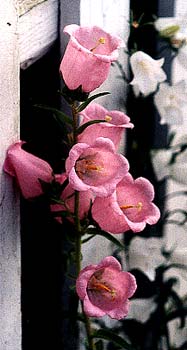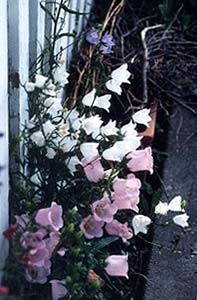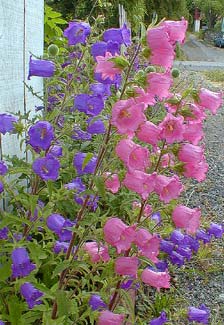
Rose Canterbury Bells
"What with the noise of their singing, & with the sound of their piping, & with the jangling of their Canterbury bells, & with the barking out of dogs after them, they make more noise than if the King came there away, with all his clarions & many other minstrels."
-Geoffrey Chaucer
(1343-1400)
(1343-1400)
The large-belled pink campanula is C. medium Rose Canterbury Bell. For has been one of two species of campanulas that greet us daily, together with several penstemons, right next to the mailbox. The other species includes two varieties of C. persicifolia, the Peachleafed Bellflower, or Peachbells. They can be seen all blooming together in the second photo (the first & second photo were taken in July, 2002).
The mailbox sits on a fence post, & as some kinds of campanulas have a tendency to become blossom-heavy & tip over, the fence itself provides a de facto trellis for the bloom stalks. The Canterbury Bells, however, unlike the Peachbells, are not as much in need of bracing, having thick sturdy stalks rather than the slender flowerstalks. But if planted in windier locations, even the Canterbury Bells may need staking.
 The two species C. persicifolia & C. medium are in full bloom most of the summer, most vigorously June through August. If deadheaded regularly & not permitted to go to seed, bloom can be extended at least into early autumn for "Canterbury Bells," & I'ave had them bloom for me even after several mild frosts, all the way up to November, though the overall appearance of the plant isn't much by then.
The two species C. persicifolia & C. medium are in full bloom most of the summer, most vigorously June through August. If deadheaded regularly & not permitted to go to seed, bloom can be extended at least into early autumn for "Canterbury Bells," & I'ave had them bloom for me even after several mild frosts, all the way up to November, though the overall appearance of the plant isn't much by then.Because Canterbury Bells are shortlived biennials, the ones by the mail box vanished in time, but were replaced by a mixture of colors of Cup & Saucer Canterbury Bells, which have broad sepals that give the cup the appearance of sitting in a saucer. These are variants of the same species, C. medium var calycanthema. "Canterbury Bells" has flowers twice the size of the Peachbell varieties it shared ground with, & the "Cup & Saucer" Canterbury Bells have still larger blooms.
Additional Canterbury Bells were planted alongside the garage amidst beebalms & penstemons. One of these is shown together with 'Champion Blue' Canterbury Bell in a June 2003 photo below.
C. medium cultivars produce only basal leaves their first year, flower gorgeously their second year, then die, & are not terribly likely to self-seed successfully. Of many planted along the last four years, there have been a few specimens that provided blossoms for two years instead of three, perhaps due to our very mild climate, but this is not apt to happen often.
 In late Autumn 2002 I cut the tall stalks of all but one second-year Canterbury Bells right down to the basal leaves. That one on which I left the stalks still looked very nice & green in December, so I didn't bother it, & to my suprise that one untrimmed plant was again blooming very nicely in late January on the previous year's stalks. All the specimens were growing in identical conditions so I had no idea why this one had a different behavior. For the rest of spring, that clump that bloomed in winter struggled to regenerate itself & never did catch up to fresher clumps, but it did survive through 2003 providing two years of blossoms rather than the one flowery year usually expected of this biennial.
In late Autumn 2002 I cut the tall stalks of all but one second-year Canterbury Bells right down to the basal leaves. That one on which I left the stalks still looked very nice & green in December, so I didn't bother it, & to my suprise that one untrimmed plant was again blooming very nicely in late January on the previous year's stalks. All the specimens were growing in identical conditions so I had no idea why this one had a different behavior. For the rest of spring, that clump that bloomed in winter struggled to regenerate itself & never did catch up to fresher clumps, but it did survive through 2003 providing two years of blossoms rather than the one flowery year usually expected of this biennial.They will sometimes self-seed, but not reliably as do the Peachbells, so die out of the garden. In our climate. The basal leaves of Canterbury Bells are semi-evergreen throughout their two or rarely three years in the garden, though the foliage gets pretty worn out at winter's end.
In & around the Elizabethan Era, this species was better known as Coventry Bells, for they had naturalized & grew wild around Kent & Coventry. This occurred such a very long time ago that their origins were practically forgotten & debated, though today believed to have been introduced from the Pyrenees.
The Reverand William Hanbury in 1770 reported that the roots were popularly eaten, being "admired for their pleasant taste, frequently boiled." I've never yet cooked their roots, but eventually I hope to be able to report first-hand on their flavor.
C. persicifolia var alba, White Peachbells